 The noted blogger Fjordman is filing this report via Gates of Vienna.
The noted blogger Fjordman is filing this report via Gates of Vienna.
For a complete Fjordman blogography, see The Fjordman Files. There is also a multi-index listing here.

I was inspired to write this after reading some news stories about mead. This got me thinking about the
Indo-Europeans, one of my favorite subjects, much more fun than Mohammedans.
 Mead, which is by many Europeans today perceived as an archaic drink of Viking sagas and medieval verse, is making a minor comeback in several Western countries, thanks in part to the enthusiasm of the home-brewing community. The number of meaderies in the United States has tripled in the decade since the year 2000, although admittedly from a very low level. To modern consumers who are more accustomed to beer and wine, mead made from honey, water and yeast often comes off as rather sweet, almost like liquid marzipan. But grapes can be sweet, too, and mead can have a dry taste, depending upon how it is made.
Mead, which is by many Europeans today perceived as an archaic drink of Viking sagas and medieval verse, is making a minor comeback in several Western countries, thanks in part to the enthusiasm of the home-brewing community. The number of meaderies in the United States has tripled in the decade since the year 2000, although admittedly from a very low level. To modern consumers who are more accustomed to beer and wine, mead made from honey, water and yeast often comes off as rather sweet, almost like liquid marzipan. But grapes can be sweet, too, and mead can have a dry taste, depending upon how it is made.
As one writer points out, the drink has an advantage over beer in certain respects: “ Mead possesses what winemakers call terroir, the French term for how something — wine, cheese, honey — conjures up the landscape around it. That’s because an artisanal mead is still, at least in part, an agricultural product. With its floral and herbal aromas, a good mead vividly communicates a sense of place — think a field of orange blossoms or rosemary bushes — in a way that’s impossible for beer.” Yet it suffers from a problem: Honey has little natural acidity. Unlike the best beer and wine pairings, mead doesn’t always combine well with food.
 The bottom line is that mead is unlikely to ever again become the most important alcoholic beverage, as it was in many European nations for a very long time. It will most likely remain a drink for those with special interest and tastes, but as such, it is not unimportant. The original speakers of Proto-Indo-European consumed alcoholic drinks, at least mead and beer.
The bottom line is that mead is unlikely to ever again become the most important alcoholic beverage, as it was in many European nations for a very long time. It will most likely remain a drink for those with special interest and tastes, but as such, it is not unimportant. The original speakers of Proto-Indo-European consumed alcoholic drinks, at least mead and beer.
Authors J. P. Mallory and D. Q. Adams in The Oxford Introduction to Proto-Indo-European and the Proto-Indo-European World analyze the PIE language based on comparative linguistic research. Over the past couple of centuries, ever since European linguists became aware of the existence of the Indo-European family in the late 1700s by noticing far greater similarities in the structure and vocabulary of many languages than could have been produced merely by chance, Western scholars have tried to reconstruct the suggested vocabulary and grammar of the extinct mother language of this group based on comparisons between its younger daughter languages. The fact that they have been able to do this with any degree of certainty at all is a remarkable scholarly achievement, given that this original language has been dead for many thousands of years and not a single document written in it has been preserved.
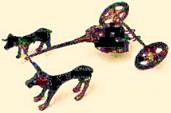 We can roughly date the time when PIE was spoken by comparing the vocabulary of this language with the physical archaeological record. For obvious reasons we cannot say with absolute certainty that all of the suggested word reconstructions are correct since no written text containing Proto-Indo-European exists, and most likely never did exist, but those who spoke PIE must have been familiar with wheeled vehicles since later, attested Indo-European tongues contain similar words for this and have not borrowed this vocabulary from each other.
We can roughly date the time when PIE was spoken by comparing the vocabulary of this language with the physical archaeological record. For obvious reasons we cannot say with absolute certainty that all of the suggested word reconstructions are correct since no written text containing Proto-Indo-European exists, and most likely never did exist, but those who spoke PIE must have been familiar with wheeled vehicles since later, attested Indo-European tongues contain similar words for this and have not borrowed this vocabulary from each other.
We cannot reconstruct a very elaborate wardrobe for the Proto-Indo-European speakers, but they probably had some form of blanket wrap which, as we know, can vary greatly in shape and size from a kilt to a cloak or a shroud. We also have an early regional word for “shoe,” most likely some type of leather shoe; the Tyrolean natural mummy “Ötzi the Iceman” from around 3300 BC wore leather soles and fur uppers. Neolithic shoes were also made of bast.
Skin garments have been employed for tens of thousands of years and remain in use to this day. The spread of flax, and to a lesser extent hemp, was a product of the Neolithic Era. From roughly 7000-3500 BC, the recovery of textiles from European archaeological sites is almost exclusively of linen or some other plant material. The words for a white linen garment in several Indo-European languages, for instance the well-known ancient Roman tunica, appear to be borrowed from Near Eastern Semitic tongues, for instance the Akkadian term kitinnu.
There is a belief among some archaeologists that the Indo-European language family originated among the food producers of the Near East and “was swept quickly forwards in the fifth millennium as the language of the colonizing farmers.” This hypothesis is not convincing if one takes the linguistic evidence into account, which rather points to the fourth millennium.
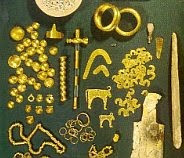 Some of the terms for containers may suggest vessels made of wood or skin, but their terms for the manipulation of clay and extensive evidence for domestic cereals clearly indicate that the speakers of PIE possessed a ceramic inventory. The early Indo-European languages shared what an archaeologist might term a late Neolithic vocabulary. There is a range of domestic animals (cattle, sheep, goat, pig, dog) and cereals (grain, barley) and the tools and techniques to process them (plough, harrow, sow, thresh, chaff, grind) and store the result (pot). The vocabulary associated with metallurgy is very restricted and includes copper, gold and silver, but not iron. Copper was utilized in the Balkans well before 5000 BC. Gold does not appear anywhere until the fifth millennium; the Varna cemetery near the Black Sea in Bulgaria from ca. 4200 BC contains many gold objects. Silver doesn’t appear anywhere before 4000 BC, after which we can find it in parts of Eastern Europe; it appears somewhat later in the Aegean.
Some of the terms for containers may suggest vessels made of wood or skin, but their terms for the manipulation of clay and extensive evidence for domestic cereals clearly indicate that the speakers of PIE possessed a ceramic inventory. The early Indo-European languages shared what an archaeologist might term a late Neolithic vocabulary. There is a range of domestic animals (cattle, sheep, goat, pig, dog) and cereals (grain, barley) and the tools and techniques to process them (plough, harrow, sow, thresh, chaff, grind) and store the result (pot). The vocabulary associated with metallurgy is very restricted and includes copper, gold and silver, but not iron. Copper was utilized in the Balkans well before 5000 BC. Gold does not appear anywhere until the fifth millennium; the Varna cemetery near the Black Sea in Bulgaria from ca. 4200 BC contains many gold objects. Silver doesn’t appear anywhere before 4000 BC, after which we can find it in parts of Eastern Europe; it appears somewhat later in the Aegean.
The earliest evidence for the plough anywhere is about the sixth millennium BC in the Near East, with solid evidence for ploughing in Europe not much before 4000 BC; cultivation during the earliest Neolithic was associated with digging sticks. As we shall see, the speakers of PIE were familiar with honey and probably collected it from honeybees, yet there was an absence of honeybees east of the Urals. Their language exhibits strong links with speakers of Proto-Uralic and weaker links with speakers of languages from the Caucasus. In combination, this evidence points to an area west of the Urals, between the Urals and the Caucasus, in the steppes of the Ukraine and western Russia, or what is now called the Pontic-Caspian region.
The reconstructed vocabulary when compared with the archaeological record strongly suggests that Proto-Indo-European was spoken well after 4000 BC and had not begun to seriously expand and break apart into various Indo-European branches until after 3500 BC, when we have the oldest secure evidence of the existence of wheeled vehicles. Woven woolen textiles are made from long wool fibers of a type that did not grow on wild sheep. Sheep with long wooly coats are genetic mutants bred just for that trait. Wool appears largely to be a development of the fourth millennium BC. We have unambiguous evidence for a PIE word for “wool.” This constitutes yet another piece of evidence that PIE was spoken after 4000 BC.
All things considered, the first phase of the Indo-European expansion was probably not associated with the slower diffusion of agriculture but with the faster spread of wheeled vehicles after 3500 BC. Whether such vehicles directly triggered the initial IE expansion is not known, but it seems plausible that they aided this by improving mobility, thereby making previously useless steppe grasslands available and converting them into useful animal protein.
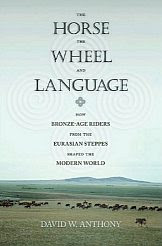 In his detailed work The Horse, the Wheel, and Language: How Bronze-Age Riders from the Eurasian Steppes Shaped the Modern World, Professor David W. Anthony reminds us that it would be difficult to exaggerate the immediate importance of the first wheeled transport:
In his detailed work The Horse, the Wheel, and Language: How Bronze-Age Riders from the Eurasian Steppes Shaped the Modern World, Professor David W. Anthony reminds us that it would be difficult to exaggerate the immediate importance of the first wheeled transport:
“Before wheeled vehicles were invented, really heavy things could be moved efficiently only on water, using barges or rafts, or by organizing a large hauling group on land. Some of the heavier items that prehistoric, temperate European farmers had to haul across land all the time included harvested grain crops, hay crops, manure for fertilizer, firewood, building lumber, clay for pottery making, hides and leather, and people. In northern and western Europe, some Neolithic communities celebrated their hauling capacities by moving gigantic stones to make megalithic community tombs and stone henges; other communities hauled earth, making massive earthworks. These constructions demonstrated in a visible, permanent way the solidity and strength of the communities that made them, which depended in many ways on human hauling capacities. The importance and significance of the village community as a group transport device changed profoundly with the introduction of wagons, which passed on the burden of hauling to animals and machines, where it has remained ever since. Although the earliest wagons were slow and clumsy, and probably required teams of specially trained oxen, they permitted single families to carry manure out to the fields and to bring firewood, supplies, crops, and people back home.”
The clearest proof of its impact was the speed with which wagon technology spread, so rapidly that we cannot say exactly where the wheel-and-axle principle was invented. The technology spread rapidly over much of Europe and the Near East before and after 3000 BC.
Where Proto-Indo-European was first spoken has been debated for more than two centuries, sometimes in a politicized manner. Although the question has not been fully settled, I agree with David W. Anthony when he says that “I believe with many others that the Proto-Indo-European homeland was located in the steppes north of the Black and Caspian Seas in what is today southern Ukraine and Russia. The case for a steppe homeland is stronger today than in the past partly because of dramatic new archaeological discoveries in the steppes.”
Many specialists have simply assumed that the earliest wagons were produced in Mesopotamia because ancient Europeans were perceived as being too “backward” to do this, but a possible prototype did exist in Europe in the form of Mesolithic and Neolithic bent-wood sleds, doweled together with fine mortise-and-tenon joints. Right up to the twentieth century AD, it made sense to park your carriage in the barn for the winter and resort to sleds (or skis), which are often more effective than wheels in snow since they don’t get easily stuck.
It is possible that skis were independently developed in several locations, but some of the first evidence we have of them comes from rock drawings in Scandinavia that are nearly 5,000 years old. The Sami peoples living in northern parts of the Nordic countries have long been known for their skiing skills. The Norwegian skier Sondre Nordheim (1825-1897) has been credited, justly or not, with a number of major innovations in this discipline and after 1860 used bindings of willow, cane and birch root around the heel from each side of the toe strap to fasten the boot to the ski. He won a ski jumping competition at Telemark, Norway in 1866.
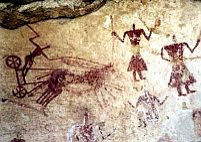 It was in the fourth millennium BC that wheeled transport first appeared in world history, across a vast region from present-day Denmark, Germany and Bronocice in Poland via the Black Sea to Mesopotamia, beginning around 3500 BC. As Philip L. Kohl says in The Making of Bronze Age Eurasia, “It is shortly after the introduction of wheeled transport that evidence for its massive utilization on the western Eurasian steppes is documented in the excavation of scores of kurgans containing wheeled carts with tripartite wooden wheels. These were not the chariots of a military aristocracy but the heavy, ponderous carts and wagons of cowboys who were developing a form of mobile Bronze Age pastoral economy that fundamentally differed from the classic Eurasian nomadism that is later attested historically and ethnographically.”
It was in the fourth millennium BC that wheeled transport first appeared in world history, across a vast region from present-day Denmark, Germany and Bronocice in Poland via the Black Sea to Mesopotamia, beginning around 3500 BC. As Philip L. Kohl says in The Making of Bronze Age Eurasia, “It is shortly after the introduction of wheeled transport that evidence for its massive utilization on the western Eurasian steppes is documented in the excavation of scores of kurgans containing wheeled carts with tripartite wooden wheels. These were not the chariots of a military aristocracy but the heavy, ponderous carts and wagons of cowboys who were developing a form of mobile Bronze Age pastoral economy that fundamentally differed from the classic Eurasian nomadism that is later attested historically and ethnographically.”
This innovation spread rapidly, which makes it harder to establish its origins, yet the earliest secure evidence of wheeled vehicles we currently possess comes from the eastern half of north-central Europe. The people who spoke Proto-Indo-European had their own terminology for axles, shafts and yokes: the PIE word for “wheel” relates to words for “to turn, spin.” By contrast, the corresponding terms in Sumerian appear to be loanwords from Indo-European.
In later Indo-European languages, basic terms in a number of categories are recognizably similar. For example, the word for the number “three” is treis in Greek, tres in Latin, drei in German, tri in Russian and Bengali and tre in Scandinavian as well as in Tocharian A from Central Asia. Words for new innovations that did not exist before (i.e., computer, motorcycle) are easily borrowed from other languages, whereas those related to more fundamental objects and relationships (i.e., mother, father, foot, air, Sun, Moon) are often much more stable.
It is not uncommon in the modern world to borrow words for borrowed technology, which is why many non-Western languages use terms similar to “telephone” today. The same principle presumably applied in ancient times. This does not by itself prove that the speakers of PIE themselves invented the wheel, although that it possible. They could theoretically have borrowed it from their neighbors but made more efficient use of it. It does, however, provide another indication that wheeled vehicles perhaps weren’t invented by the Sumerians. Wheeled transport may appear “inevitable” to us now, but let us recall that Mesoamericans and other settled American cultures still didn’t have this invention nearly five thousand years later.
It is true that Sumerian-dominated Mesopotamia after 4000 BC was an extremely dynamic region. The emergence of urban civilization there was a milestone in human history that affected a huge hinterland, from India and Egypt to the Caucasus and probably eastern parts of Europe as well. Philip L. Kohl suggests that Mesopotamia experienced a “fiber revolution” during the fourth millennium BC when it shifted from cultivating flax to herding wool-bearing sheep to produce textiles. Like many useful innovations, this one spread quickly.
Perhaps there was an exchange of innovations via the Black Sea region in the fourth millennium BC where Mesopotamians imported wheeled vehicles from the north while Europeans, including the speakers of PIE, imported wool-bearing sheep from the south. This model makes some sense in light of the archaeological and linguistic evidence we have today.
If wheeled vehicles were indeed invented by prehistoric Europeans, which is not a certainty but a real possibility, this would constitute one of the first instances when a revolutionary innovation of global importance spread from Europe. It was not to be the last. Bicycles, automobiles and other means of transport were created in modern Europe. If the first carts, too, were created on this continent in the fourth millennium BC then this would imply that almost all prototypes of the basic forms of wheeled vehicles during the past six thousand years were invented by Europeans. The only possible exception is the wheelbarrow, which may have been developed by the Chinese, yet the history of even this device is not beyond dispute; some historians claim that the wheelbarrow was independently invented in Europe.
The PIEs were familiar with horses, but whether or not these had been domesticated is a hotly debated topic in Indo-European studies. Did this event take place before or after 4000 BC? We don’t know for sure where the horse was first domesticated, but a common guess would be in far northeastern Europe, somewhere in the steppe and forest-steppe stretching from the Dnieper east to the Urals and beyond, in what is now western Russia or possibly Central Asia.
Wild horses were hunted for their meat in Paleolithic Europe. Anthony suggests that they were first domesticated by people who initially viewed them as food, a source of winter meat, since “they could feed themselves through the steppe winter, when cattle and sheep needed to be supplied with water and fodder. After people were familiar with horses as domesticated animals, perhaps after a relatively docile male bloodline was established, someone found a particularly submissive horse and rode on it, perhaps as a joke. But riding soon found its first serious use in the management of herds of domesticated cattle, sheep, and horses.”
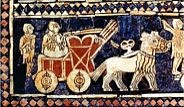 The images on the Royal Standard of Ur shows that the Sumerians in Mesopotamia were familiar with wheeled vehicles before 2500 BC, but still in the form of slow-moving carts pulled by oxen or tamed asses. This was contemporary with the Old Kingdom period when the Egyptians built their largest and most famous pyramids, yet we have no indications that they used wheels at this time. They did know wheels in the New Kingdom (1570-1070 BC), however; horse-drawn chariots were displayed in the tomb of Tutankhamun in the 1300s BC. The Battle of Kadesh (ca. 1270 BC) between the forces of the influential Pharaoh Ramesses II and the Indo-European-speaking Hittites is often cited as the largest chariot battle ever fought.
The images on the Royal Standard of Ur shows that the Sumerians in Mesopotamia were familiar with wheeled vehicles before 2500 BC, but still in the form of slow-moving carts pulled by oxen or tamed asses. This was contemporary with the Old Kingdom period when the Egyptians built their largest and most famous pyramids, yet we have no indications that they used wheels at this time. They did know wheels in the New Kingdom (1570-1070 BC), however; horse-drawn chariots were displayed in the tomb of Tutankhamun in the 1300s BC. The Battle of Kadesh (ca. 1270 BC) between the forces of the influential Pharaoh Ramesses II and the Indo-European-speaking Hittites is often cited as the largest chariot battle ever fought.
The earliest attested wheels were solid disk wheels. The invention of the spoke made wheels lighter and transportation swifter, with spoked wheels and chariots appearing around 2200-2000 BC. As we have seen, it is likely that people in the western Eurasian steppes were the first to tame the horse. The horse-drawn chariot was introduced before 2000 BC in the steppes of northeastern Europe, which aided a new phase of the Indo-European expansion. The “mother language” — Proto-Indo-European — was most likely dead as a spoken language by about 2500 BC, but the IE expansion continued thereafter through its daughter languages.
Judged by the available evidence it is a plausible working hypothesis that after 2000 BC, aided by the new horse-drawn spoke-wheeled chariot, speakers of Proto-Indo-Iranian moved from somewhere around the Ukraine or western Russia into Iran, Afghanistan, northern India and Central Asia, eventually giving birth to the languages we know as Vedic Sanskrit and Old Persian. A few of them may have been preserved as the Tarim mummies in western China.
A suggested PIE word with good attestation is “honey,” which was something like *mélit. It is found in many regions of Indo-European speech, for instance as Latin mel. It has one Indo-Iranian cognate in the form of melition, a drink of the Scythians. The fermented alcoholic drink made from honey, mead, is PIE *médhu and is found in Greek méthu, wine; Latvian medus, honey, wine; Old Church Slavonic medu, honey, wine; Sanskrit madhu, honey, wine; and in Central Asia with Tocharian B as mit, honey, and mot, “alcoholic drink.” Honey in modern Portuguese and Catalan is mel; in Spanish and French miel; in Italian miele and in Romanian miere. The same word in the Slavic languages Czech, Slovak, Serbian, Croatian, Russian and Ukrainian is med and in Polish miód, whereas “mead” in Scandinavian is mjød; in Icelandic mjöður; in Welsh medd; in Dutch mede; and in German Met. These similarities are not accidental. They date back in a straight line to Proto-Indo-European nearly six thousand years ago, making mead as a word and concept one of the oldest recognizable elements of European culture in active use today. In fact, mead as a drink may well predate agriculture itself in Europe.
The Chinese and Uralic words for “honey” as well as a few other terms appear to be loanwords from Indo-European. Consequently, honey is méz in modern Hungarian. Interestingly, mead is called sima in Finnish. Soma was an intoxicating drink possibly related to mead that was in ritual use among Indo-Iranians in the eastern regions of Indo-European speech. It is mentioned in the Rigveda and in the Avesta, the sacred texts of Zoroastrianism.
 A number of remarkably well-preserved mummies from the second millennium BC have been recovered in the dry Tarim Basin of Central Asia, dominated by the Taklamakan Desert and located in what is today far western China. Several of the corpses have European features and blond or reddish-brown/copper-colored hair. The oldest ones such as the Loulan Beauty date back to the early second millennium. “From around 1800 BC, the earliest mummies in the Tarim Basin were exclusively Caucausoid, or Europoid,” says Professor Victor Mair of Pennsylvania University. The textile expert Elizabeth Wayland Barber reckons that their cloth can be traced back to the Black Sea region of Eastern Europe. DNA samples have confirmed the northwest Eurasian origins of several of the ancient mummies found in this area.
A number of remarkably well-preserved mummies from the second millennium BC have been recovered in the dry Tarim Basin of Central Asia, dominated by the Taklamakan Desert and located in what is today far western China. Several of the corpses have European features and blond or reddish-brown/copper-colored hair. The oldest ones such as the Loulan Beauty date back to the early second millennium. “From around 1800 BC, the earliest mummies in the Tarim Basin were exclusively Caucausoid, or Europoid,” says Professor Victor Mair of Pennsylvania University. The textile expert Elizabeth Wayland Barber reckons that their cloth can be traced back to the Black Sea region of Eastern Europe. DNA samples have confirmed the northwest Eurasian origins of several of the ancient mummies found in this area.
Indra, the Vedic god of thunder, is described in the Rigveda as having blond or red/copper-colored hair and beard, very similar to his Slavic and Germanic counterparts such as Thor in Europe. These hair colors are specifically European genetic traits that are rare elsewhere. Not totally unheard of, but rare. Indra was a preeminent drinker of soma, just like Thor was a great drinker of alcoholic beverages. Indra plays a part in the Jain and Buddhist mythology of India, but in Brahamanic times he was supplanted by Vishnu and Shiva as the most important gods.
The Indus Valley Civilization in northwestern India had cities and a writing system before 2000 BC. The people of the Rigveda had no words related to writing and did not live in cities, but their enemies lived in walled strongholds. We cannot say based on the reconstructed Proto-Indo-European lexicon alone with certainty where PIE was initially spoken, but the flora and fauna mentioned there does indicate a cool northern climate, not warmer India.
There is no secure PIE word for brick. “Bricks were made of sun-dried (and later fired) mud/clay and are the diagnostic building technique of the Neolithic (and later periods) in Anatolia, South-West Asia, and central Asia with some evidence from Neolithic Greece, but beyond Macedonia they are essentially unknown during the Neolithic. In short, the evidence for architectural terms in Proto-Indo-European is most consistent with an architectural tradition somewhere in temperate Eurasia where houses were exclusively built of timber.”
In the ancient world, intoxication was not always seen as reprehensible; it could sometimes be inspiring and creating a bond between man and the gods. The Greek term for ritual intoxication was enthousiasmos, divine possession or “having the god within,” from en, “in, within,” and theos, “god,” from which we derive the word “theology.” Over time, enthusiasm simply gained the meaning of “strong liking for something,” religious or not. To the Norse, the “mead of poetry” was an intoxicating beverage that made anyone who drank it a poet.
Both the Old and New Testaments of the Bible are consistent in their condemnation of drunkenness, but Jews and Christians can use modest amounts of wine in their religious ceremonies, in sharp contrast to the practices of Muslims. The medieval Church saw wine as a gift from God and advocated its moderate use while rejecting abuse of it as a sin. The religious use of wine among Christians was anticipated in the cult of Dionysus, son of Zeus and the ancient Greek god of wine, theater and agriculture, known as Bacchus to the Romans.
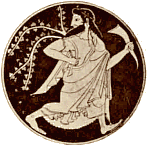 Dionysus, the beloved god of wine, is mentioned already in the Greek Linear B tablets from ca. 1500-1300 BC, but he then appears to be a god of intoxication rather than wine. The evidence is sparse, but it is conceivable that he was originally a mead god before becoming associated with wine. The ancient Greeks did not believe that they had always drunk wine. Max Nelson explains in The Barbarian’s Beverage: A History of Beer in Ancient Europe:
Dionysus, the beloved god of wine, is mentioned already in the Greek Linear B tablets from ca. 1500-1300 BC, but he then appears to be a god of intoxication rather than wine. The evidence is sparse, but it is conceivable that he was originally a mead god before becoming associated with wine. The ancient Greeks did not believe that they had always drunk wine. Max Nelson explains in The Barbarian’s Beverage: A History of Beer in Ancient Europe:
“The Greek philosopher Porphyry from the third century AD claimed, on the authority of ‘Orpheus’ (a mythic poet), that Zeus intoxicated Cronus with honey (that is, mead) since there was no wine at the time. The second century AD author Plutarch claimed that Jews used mead for their libations before wine was discovered. One ancient source even humorously stated that mead, then used by Illyrians, was once made among Greeks but that the recipe had been lost. Though we can certainly discount this explanation of why mead was no longer drunk by Greeks, these authorities may in fact be right that mead was known to Greeks before wine. The most telling clue is the fact that the Greek word for ‘intoxicant’ is methu, which likely meant mead…Though already in Homer methu is equated with oinos (presumably wine), there are texts in which the two seem to be opposed, thus perhaps showing that the former retained at least occasionally its original meaning of mead.”
Mead was enjoyed in the Baltic countries, Scandinavia, Poland, Russia, the Ukraine, Central Europe and in Wales more than in England. It continued to be a popular drink in northern regions for millennia, but consumption diminished as beer drinking spread. In Russia, it was widely drunk long after its decline in popularity in the West. It is still possible to buy bottles of freshly made mead from commercial producers, but it would be fair to say that the drink has by now become a marginal product compared to the great importance it once enjoyed.
People in India have been crystallizing cane sugar for more than 2,000 years. Tropical cane sugar was known in Europe by late medieval times, at least since the Crusades. It was soon grown in Sicily and Madeira. From the fifteenth century on it was used alongside honey in court kitchens and rich households to make sweets for dessert. With the beginning of the colonial period in Western Europe, sugar cultivation was spread to the New World, starting with the Portuguese and the Spanish and continuing with the Dutch, the British and the French. As prices declined, sugar became increasingly common and was used for jams and candy as well as added to the new tropical drinks, cacao, tea and coffee. The availability of imported sugar gradually reduced the traditional importance of honey as a natural sweetener, although several European countries continue to be major producers of honey to this day.
The use of sugar grew in Western Europe during the eighteenth century, primarily because of cultivation by African slaves in the Caribbean, but it wasn’t yet a regular part of the diet of ordinary people, with Britain as a partial exception. In 1747, during the early stages of the European chemical revolution, the German chemist Andreas Sigismund Marggraf (1709-1782) discovered that the sugar in a sugar beet is identical to that in sugarcane. In 1802 the first beet-sugar refinery began operations, after which it provided “a cheap new source of calories as well as a vast extension to the range of tastes available to the general public.”
Andrew Sherratt in The Oxford Illustrated History of Prehistoric Europe writes about the transformation of early agrarian Europe during the later Neolithic, Copper Age and Early Bronze Age, around 4500-2500 BC, when a belt of megalithic monuments stretched along the Atlantic coastlands of far western Europe, the Iberian Peninsula and western Mediterranean islands. There is a marked and rapid shift in the archaeological record starting just before 3000 BC and continuing until after 2000 BC, especially in northern regions of Central and Eastern Europe, with what archaeologists call the Pit Grave and Corded Ware cultures.
The so-called Bell-Beaker culture, named after their distinctive pottery drinking vessels, soon included the far western fringes of Europe in this continent-wide configuration. Many scholars suspect this was associated with the start of the first Indo-European expansion. The Corded Ware culture burials were usually single graves in pits. The Neolithic had been a period of communal enterprises and ritual centers. Compared to this, the emphasis that the Bell-Beaker and Corded Ware cultures placed on the individual constituted a radical change.
In a tomb from ca. 3000 BC at Plachidol in northern Bulgaria, the remains have been found of a vehicle with four solid wooden wheels. It is an outlier of the main distribution of such burials on the steppes north of the Black Sea, where they gave name to the Pit Grave culture. A new drinking culture and drinking vessels were imported to Eastern Europe at this time.
From 3500-2500 BC, European pottery shows diversity of types, especially in the decorated vessels used for ceremony and display. They record a growing tension between conflicting models of appropriate behavior, particularly the socially expressive consumption of food and drink. In northeastern Europe we can detect very rapid changes after 3000 BC with the spread of a new material culture where emphasis shifted from fixed ceremonial centers to mobility and portable wealth. The symbol of this change was the type of pottery known as Corded Ware, with comparable drinking vessels and stone battle-axes found in male graves in a belt stretching from Switzerland via Denmark and Poland to present-day Moscow in Russia:
“Graves containing these items now lay in the centre of a circular mound. This set of personal equipment and individual burial rite integrated elements both of southern and eastern origin. The emphasis on drinking had reached southern Europe from Anatolia, and now, in rustic northern mugs, dimly echoed the sophistication of the silver wine cups in use in the Aegean. These were no empty containers, and to fill them with the appropriate stimulant required a concentration of scarce resources. The corded decoration may hint that its contents contained more than the weak alcohol obtainable from forest honey and wild fruits, for if cannabis was smoked on the steppes it could have been infused by neighbouring drinking cultures.”
The new material culture was slowest in penetrating into Britain and the far western fringes of the Continent where megalithic, ritual-centered societies lasted longest. The relatively sudden appearance of Bell-Beakers on the western edge of Europe indicates the intrusion of a whole range of novel elements which had accumulated in central and northern Europe and which were adopted together in what appears to have been radical upheaval. Andrew Sherratt again:
“The disruptive character of this process is epitomized in two of these features (both of which were to have an equally dramatic impact some 4000 years later on the New World): alcohol and horses. That beakers were used for something like mead, flavoured with herbs such as meadowsweet or wild fruits, has been demonstrated from pollen grains found in the bottom of such drinking-cups. As with Corded Ware beakers, these vessels suggest individual hospitality rather than the great communal ceremonies at central gathering places which had hitherto dominated the ritual life of western Europe: the dry detail of pottery typology understates the social reality of a clash of cultural values. So, too, with the first appearance of horses in areas such as Spain or the British Isles: the animals were few in number, but their impact must have been a powerful one. Along with these, somewhat later, came metallurgical skills and woollen textiles, which by absorbing dyes could present a more colourful appearance than garments of skin or linen.”
Whether the Indo-European expansion literally introduced alcoholic beverages to these regions is debatable. Agriculture was well-established in much of northern Europe by 3000 BC. Beers made from grains had probably already been brewed there prior to this, and it is possible that fermented beverages had been made from honey or wild berries earlier. But the IE expansion may well have spread a new cultural emphasis on drinking rituals in Europe.
Ancient Europeans most likely made more extensive use of color in their clothing and art than they have normally been given credit for, but this hasn’t always survived in the archaeological record. Traditionally, Antiquity was by later generations taken to mean white marble statues, but the ancient Greeks thought of their gods in color and often portrayed them that way, too.
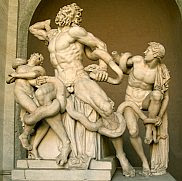 White marble became the norm in European Renaissance art after Classical antiquities were rediscovered. The sculpture of the Trojan priest Laocoön and his two sons struggling with serpents (discovered in 1506 in Rome) is one of the greatest early finds. Knowing no better, Renaissance artists in the sixteenth century took the bare stone at face value. Michelangelo and others emulated what they believed to be the ancient aesthetic, leaving the stone of most of their marble statues in its natural color. By the nineteenth century, though, scattered traces of their original, multicolored surfaces accumulated. At the turn of the twenty-first century, the German archaeologist Vinzenz Brinkmann and others armed with modern technology and ultraviolet light have tried to reconstruct the original, bright colors of old temples and statues.
White marble became the norm in European Renaissance art after Classical antiquities were rediscovered. The sculpture of the Trojan priest Laocoön and his two sons struggling with serpents (discovered in 1506 in Rome) is one of the greatest early finds. Knowing no better, Renaissance artists in the sixteenth century took the bare stone at face value. Michelangelo and others emulated what they believed to be the ancient aesthetic, leaving the stone of most of their marble statues in its natural color. By the nineteenth century, though, scattered traces of their original, multicolored surfaces accumulated. At the turn of the twenty-first century, the German archaeologist Vinzenz Brinkmann and others armed with modern technology and ultraviolet light have tried to reconstruct the original, bright colors of old temples and statues.
The PIE lexicon emphasizes a diet that included meat, broth, salt, dairy products and the consumption of alcoholic beverages: beer, mead and perhaps wine. Sheep and goats can be milked, but the great abundance of terms for milk products such as cheese or butter in early Indo-European history suggests the more intensive exploitation of cattle for milk. There are several PIE words related to milk. One of them was something like *glakt, which is attested in Hittite as galaktar (“milky fluid” or “soothing substance”), in Latin as lac, milk, and finally in the Greek term gala. Yes, this is the same word we encounter in the modern term “galaxy.”
The name “Milky Way” for our own galaxy dates back to Antiquity. The infant Heracles, the mightiest of the Greek heroes (known as Hercules to the Romans), son of Zeus and a mortal woman, was placed at the bosom of the goddess Hera while she was asleep so that he would drink her divine milk and become immortal. Hera woke up and removed him from her breast, in the process spilling some of her milk across the sky. The term “galaxy” — a large system of stars, dust and gas held together by gravity — is consequently derived from the root “milky.”
Slavic, Greek and Indo-Iranian share a word for “curdled milk.” In the Slavic languages we have for instance Russian torog, “curds, soft cheese.” In Greek this is reflected in turos, cheese, and bouturos, literally “cow-cheese,” that is, butter. This term for “cow’s cheese” was borrowed into the Latin butyrum — buturum and then into modern English as butter.
The ancient Greeks and Romans did not use butter much in their cooking. Pliny the Elder was familiar with the substance, but mentioned it as a delicate food of the northern barbarians. It was almost unknown in Italy when the Renaissance period began, since it would spoil much more rapidly in the warm Mediterranean climate than in the cooler northern regions. Butter is produced by churning the cream from cows’ milk, although it is possible that it was first made accidentally from sheep or goat’s milk somewhere in the Fertile Crescent many millennia ago.
Scandinavian (Norse) Vikings dominated much of northern Europe from the late eighth century on, trading as well as plundering. At home they were free farmers. The Viking Age ended in the eleventh century AD when they faced stronger states abroad and Christianization at home, at which point Scandinavia became integrated into the literate Christian civilization of Europe. From Sweden they went down the rivers of Eastern Europe to Kiev and the Black Sea and founded what would later become the Russian state. Norwegians went to Scotland, Ireland and the North Atlantic. Dublin was the richest of the Norse colonies in Ireland.
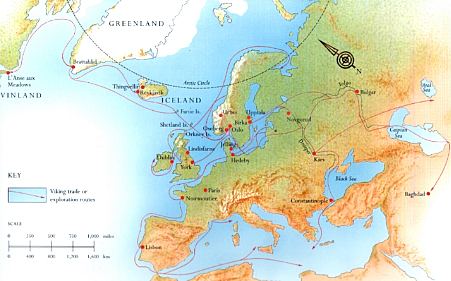
The Viking impact was strong in the British Isles, destructive but also transformative. From Denmark they raided and settled in Normandy and Brittany. The northeastern parts of England where the Vikings settled became known as the
Danelaw because Danish laws and customs, not English, prevailed there. Some scholars argue that certain legal institutions such as the ancestor of the modern grand jury may have originated in the Danelaw.
Danegeld was an English tax levied in a largely unsuccessful attempt to buy off the invaders. Charles “the Simple” III in the year 911 signed a treaty with the Viking leader Rollo for what would become Normandy along the English Channel coast of northern France. Their descendants of mixed Norse and French origins, the Normans, would successfully conquer England in 1066.
The driving force behind the Viking expansion is not known, but their ships were perhaps the fastest craft in the world of their time. Scandinavia and the Baltic Sea was originally one of the most remote regions of Europe. Rock carvings from around 1500 BC demonstrate that boat-building with oared vessels was known here by that time and most likely long before that, but the first depictions of sailing vessels, a principle that was well-established in the ancient Mediterranean world, come from the southern Swedish island of Gotland around AD 600. Soon after this, the Scandinavians developed remarkably fast and mobile sailed-and-rowed longships that could also be used on rivers. Author Else Roesdahl states categorically that “Without sails, the Vikings’ far-flung exploits would have been impossible.”
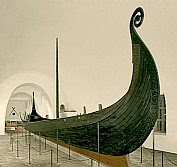 Dendrochronology (tree-ring dating) shows that the well-preserved Oseberg ship was buried in AD 834. The Gokstad ship was found beneath a burial mound at a farm in Vestfold. It is 24 meters long, 5 meters wide and very seaworthy. Both ships can be seen in the Viking Ship Museum in Oslo, Norway. Tønsberg in Vestfold was probably founded in the 800s AD and is one of the oldest still-existing towns in Scandinavia. The only known pre-modern oceanic exploration in the world that can match the Viking expansion is the Polynesian expansion of peoples speaking Austronesian languages across the islands of the vast Pacific Ocean.
Dendrochronology (tree-ring dating) shows that the well-preserved Oseberg ship was buried in AD 834. The Gokstad ship was found beneath a burial mound at a farm in Vestfold. It is 24 meters long, 5 meters wide and very seaworthy. Both ships can be seen in the Viking Ship Museum in Oslo, Norway. Tønsberg in Vestfold was probably founded in the 800s AD and is one of the oldest still-existing towns in Scandinavia. The only known pre-modern oceanic exploration in the world that can match the Viking expansion is the Polynesian expansion of peoples speaking Austronesian languages across the islands of the vast Pacific Ocean.
The French food historian Maguelonne Toussaint-Samat notes that “The influence of the example set by the Vikings and Normans when butter consumption began is obvious; in those parts of Western Europe which they later colonized, there is no mention of butter among the dues in kind collected by the officers of the Merovingian, Carolingian and even the first Capetian kings of France until the conquerors had really settled in. Not until the fourteenth century did the Church have anything to say about butter in its directives for fasting. Meanwhile the eating of butter spread from Normandy and the Loire valley to the Netherlands and Switzerland, where people also began to make it. In the twelfth century no one was sure whether, unlike lard, it could be considered suitable for fast days, a suggestion made by an abbot of Saint-Denis. As Jean-Louis Flandrin points out, butter consumption is a natural development in regions suitable for cattle-breeding. In such places, popular taste and the local economy had gone right over to butter as a cooking fat within 400 years.”
The Scandinavians and later the Bretons, Flemish and Icelanders became famous for their butter exports. The Catholic Church, “well knowing on which side its own bread was buttered, made money by selling dispensations to eat butter” on fast days. Coincidentally, those countries which use butter for cooking are nearly identical with those which broke away from the Roman Catholic Church in the sixteenth century. Obviously, many of the northern European regions which became Protestant also have a very long history of dairy farming.
Athena was the daughter of Zeus. She competed with her uncle, the sea god Poseidon, brother of Zeus and Hades, for the affection of the Athenians. Poseidon provided them with a horse, handsome and strong. According to an alternative version he struck the Acropolis with his trident and created a saltwater spring. Athena provided them with an olive tree. The Greeks preferred her gift and named the city of Athens after her. On the Acropolis hill above it, the Parthenon marble temple contained a huge statue of her, Athena Parthenos, made of gold and ivory. It was designed by the great Athenian sculptor Phidias (ca. 490-430 BC). He also created the Statue of Zeus at Olympia, one of the Seven Wonders of the ancient world.
The olive tree was a symbol of wisdom and peace and has been grown throughout the Mediterranean region for thousands of years. The nude male athletes who won the original Olympic Games were crowned with olive leaves. Its fruits are the source of olive oil, now used primarily for cooking but for much more than that in Antiquity, including as a medicine.
Those European populations which have settled in the Americas, Australia and Africa in recent centuries have preferred to eat the fats of the customary diets of their countries of origins. The popularity of oil and butter roughly coincides with the official spoken language. People in English-speaking countries tend to eat much less oil compared to those in Spanish-speaking countries, for example. French-speaking areas, like France itself, are half-and-half.
In the famous fairy tale about the young girl and the big bad wolf, Little Red Riding-Hood carried to her grandmother a small pot of butter. Butter occupied a prominent place in many ancient religious ceremonies. People in northern India of Vedic times invoked butter as a primordial deity; among the early Indo-Europeans it is mentioned many times in the Rigveda:
“Indeed, butter thrown on a fire will make it crackle as it nourishes and regenerates the flames. It is regenerating life itself. The offering of butter is a form of prayer, a source of sacred energy such as might create a universe. The butter made from the milk of Indian sacred cows was intended for religious ceremonies; it was a purified, clarified, liquid butter.” Indians still use the clarified butter called ghi or ghee for cooking. Butter with its sunny, golden color was often associated with fire in folk memory. “Whether in the rites described in the Vedas, or in magical Celtic practices, butter features as a substitute for those natural golden treasures, honey and virgin wax, which themselves have sometimes been called the butter of the bees.”
Cheesemaking is a very ancient activity in societies that extensively utilize animal milk. Milk spoils quickly, and cheese is the most effective means of preserving milk nutrients over a period of time. Cheese does not by itself occur naturally; it has to be created. There is perhaps no other foodstuff — not even bread — that lends itself to such a great range of tastes and forms even within the same basic technical framework of curdled and cured milk. This local variety is the product of a range of possible treatments as well as different kinds of milk, combined with many different bacteria, enzymes and molds that enter into the cheese and give it much of its distinctive flavor. The variety of cheese was traditionally, and to a degree not maintained in any other product (with the possible exception of wine), identified with place.
Fungi constitute a kingdom of organisms that include microorganisms such as yeasts and molds as well as the larger mushrooms. They can be found virtually everywhere in large numbers. Mushrooms are the umbrella-shaped fruiting bodies of certain fungi. Many are poisonous to us and a few have hallucinogenic properties. Among popular edible mushrooms we find Cantharellus cibarius, the golden chanterelle, and Agaricus bisporus — commonly known as Champignon mushroom. Truffles are subterranean fungi prized as a great delicacy in France, Italy, Spain and Greece for centuries. The study of fungi is called mycology.
 Author Toussaint-Samat reminds us that molds are fungi, too. Most of them are not good to eat, “but blue cheeses like Roquefort and Gorgonzola owe their delicious blue veining to a microscopic species of mould called Penicillium roqueforti. The velvety white rind of Camembert and similar cheeses is produced by Penicillium camemberti. Antibiotics were isolated from certain strains of Penicillium. Beer and wine yeasts are also fungi, the moulds of barley and of grape must respectively. Without these fungi, invisible to the naked eye, bread would not rise and champagne would not sparkle. Yeasts are a true food in their contribution to our intake of protein, vitamins and enzymes; we could not do without them.”
Author Toussaint-Samat reminds us that molds are fungi, too. Most of them are not good to eat, “but blue cheeses like Roquefort and Gorgonzola owe their delicious blue veining to a microscopic species of mould called Penicillium roqueforti. The velvety white rind of Camembert and similar cheeses is produced by Penicillium camemberti. Antibiotics were isolated from certain strains of Penicillium. Beer and wine yeasts are also fungi, the moulds of barley and of grape must respectively. Without these fungi, invisible to the naked eye, bread would not rise and champagne would not sparkle. Yeasts are a true food in their contribution to our intake of protein, vitamins and enzymes; we could not do without them.”
The dairy was almost the exclusive province of women until the modern era, from the proverbial “milkmaid” to the mistress of the household. Farm women were the marketers of butter and cheese, sometimes taking their products to nearby village and town markets:
“Dairy work was hard work, typically starting with the first milking at 3:00 or 4:00 in the morning and going well into the evening. Cheese was particularly demanding, since timing was crucial — the first batch of cheese was typically started some hours after milking, after the milk had cooled, but before there was any danger of spoilage. It was customary for the women of the household to do all the work themselves: heating the milk in vats, preparing and adding rennet (typically made from calves’ stomachs) to curdle the milk and set it, cutting up the curds and stirring at length, straining, salting, molding, pressing, turning, and so forth. All of this was guided by knowledge passed on from mother to daughter, from mistress to maid. There were numerous techniques for managing the rate of curdling, controlling the amount of liquid or whey in the new cheese, and manipulating the flavors of the result. This was women’s knowledge, and its female nature was unchallenged until the eighteenth century.”
Just as had been the case with beer previously, when cheese eventually became a product made on a larger and more industrial scale, it passed from the household — traditionally the domain of women — into the wider society and thereby became more of a male preserve.
The French chemist Hippolyte Mège-Mouriès (1817-1880) in 1869 came up with a butter substitute made from beef fat and milk which he called “margarine.” In the early 1870s, Antonius Johannes Jurgens (1805-1880) and Simon van den Bergh (1819-1907) created the world’s first margarine factory in Brabant in the southern Netherlands. Their company later became a part of the Anglo-Dutch multinational corporation Unilever, which owns brands related to foods, beverages, soaps and many other products for household consumption.
The breakthrough for mass consumption of this new product came in the early twentieth century following the discovery of a process for hardening oil, which made it possible to use oily plants such as copra, sesame and palm nuts, and also groundnuts and soya beans. The popularity of this “artificial butter” admittedly owed more to its cheap price than to its taste. Margarine thus reflects both the promise and the pitfalls of industrialized food production.

 Eulex — the European Union’s law enforcement and legal assistance mission to Kosovo — has been invited to leave the north of the “country” because conditions are deemed unsafe.
Eulex — the European Union’s law enforcement and legal assistance mission to Kosovo — has been invited to leave the north of the “country” because conditions are deemed unsafe.
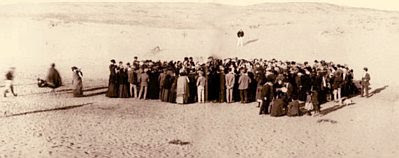



 Mead, which is by many Europeans today perceived as an archaic drink of Viking sagas and medieval verse, is making a minor comeback in several Western countries, thanks in part to the enthusiasm of the home-brewing community. The number of meaderies in the United States has
Mead, which is by many Europeans today perceived as an archaic drink of Viking sagas and medieval verse, is making a minor comeback in several Western countries, thanks in part to the enthusiasm of the home-brewing community. The number of meaderies in the United States has  The bottom line is that mead is unlikely to ever again become the most important alcoholic beverage, as it was in many European nations for a very long time. It will most likely remain a drink for those with special interest and tastes, but as such, it is not unimportant. The original speakers of Proto-Indo-European consumed alcoholic drinks, at least mead and beer.
The bottom line is that mead is unlikely to ever again become the most important alcoholic beverage, as it was in many European nations for a very long time. It will most likely remain a drink for those with special interest and tastes, but as such, it is not unimportant. The original speakers of Proto-Indo-European consumed alcoholic drinks, at least mead and beer. We can roughly date the time when PIE was spoken by comparing the vocabulary of this language with the physical archaeological record. For obvious reasons we cannot say with absolute certainty that all of the suggested word reconstructions are correct since no written text containing Proto-Indo-European exists, and most likely never did exist, but those who spoke PIE must have been familiar with wheeled vehicles since later, attested Indo-European tongues contain similar words for this and have not borrowed this vocabulary from each other.
We can roughly date the time when PIE was spoken by comparing the vocabulary of this language with the physical archaeological record. For obvious reasons we cannot say with absolute certainty that all of the suggested word reconstructions are correct since no written text containing Proto-Indo-European exists, and most likely never did exist, but those who spoke PIE must have been familiar with wheeled vehicles since later, attested Indo-European tongues contain similar words for this and have not borrowed this vocabulary from each other. Some of the terms for containers may suggest vessels made of wood or skin, but their terms for the manipulation of clay and extensive evidence for domestic cereals clearly indicate that the speakers of PIE possessed a ceramic inventory. The early Indo-European languages shared what an archaeologist might term a late Neolithic vocabulary. There is a range of domestic animals (cattle, sheep, goat, pig, dog) and cereals (grain, barley) and the tools and techniques to process them (plough, harrow, sow, thresh, chaff, grind) and store the result (pot). The vocabulary associated with metallurgy is very restricted and includes copper, gold and silver, but not iron. Copper was utilized in the Balkans well before 5000 BC. Gold does not appear anywhere until the fifth millennium; the Varna cemetery near the Black Sea in Bulgaria from ca. 4200 BC contains many gold objects. Silver doesn’t appear anywhere before 4000 BC, after which we can find it in parts of Eastern Europe; it appears somewhat later in the Aegean.
Some of the terms for containers may suggest vessels made of wood or skin, but their terms for the manipulation of clay and extensive evidence for domestic cereals clearly indicate that the speakers of PIE possessed a ceramic inventory. The early Indo-European languages shared what an archaeologist might term a late Neolithic vocabulary. There is a range of domestic animals (cattle, sheep, goat, pig, dog) and cereals (grain, barley) and the tools and techniques to process them (plough, harrow, sow, thresh, chaff, grind) and store the result (pot). The vocabulary associated with metallurgy is very restricted and includes copper, gold and silver, but not iron. Copper was utilized in the Balkans well before 5000 BC. Gold does not appear anywhere until the fifth millennium; the Varna cemetery near the Black Sea in Bulgaria from ca. 4200 BC contains many gold objects. Silver doesn’t appear anywhere before 4000 BC, after which we can find it in parts of Eastern Europe; it appears somewhat later in the Aegean. In his detailed work The Horse, the Wheel, and Language: How Bronze-Age Riders from the Eurasian Steppes Shaped the Modern World, Professor David W. Anthony reminds us that it would be difficult to exaggerate the immediate importance of the first wheeled transport:
In his detailed work The Horse, the Wheel, and Language: How Bronze-Age Riders from the Eurasian Steppes Shaped the Modern World, Professor David W. Anthony reminds us that it would be difficult to exaggerate the immediate importance of the first wheeled transport: It was in the fourth millennium BC that wheeled transport first appeared in world history, across a vast region from present-day Denmark, Germany and Bronocice in Poland via the Black Sea to Mesopotamia, beginning around 3500 BC. As Philip L. Kohl says in The Making of Bronze Age Eurasia, “It is shortly after the introduction of wheeled transport that evidence for its massive utilization on the western Eurasian steppes is documented in the excavation of scores of kurgans containing wheeled carts with tripartite wooden wheels. These were not the chariots of a military aristocracy but the heavy, ponderous carts and wagons of cowboys who were developing a form of mobile Bronze Age pastoral economy that fundamentally differed from the classic Eurasian nomadism that is later attested historically and ethnographically.”
It was in the fourth millennium BC that wheeled transport first appeared in world history, across a vast region from present-day Denmark, Germany and Bronocice in Poland via the Black Sea to Mesopotamia, beginning around 3500 BC. As Philip L. Kohl says in The Making of Bronze Age Eurasia, “It is shortly after the introduction of wheeled transport that evidence for its massive utilization on the western Eurasian steppes is documented in the excavation of scores of kurgans containing wheeled carts with tripartite wooden wheels. These were not the chariots of a military aristocracy but the heavy, ponderous carts and wagons of cowboys who were developing a form of mobile Bronze Age pastoral economy that fundamentally differed from the classic Eurasian nomadism that is later attested historically and ethnographically.” The images on the Royal Standard of Ur shows that the Sumerians in Mesopotamia were familiar with wheeled vehicles before 2500 BC, but still in the form of slow-moving carts pulled by oxen or tamed asses. This was contemporary with the Old Kingdom period when the Egyptians built their largest and most famous pyramids, yet we have no indications that they used wheels at this time. They did know wheels in the New Kingdom (1570-1070 BC), however; horse-drawn chariots were displayed in the tomb of Tutankhamun in the 1300s BC. The Battle of Kadesh (ca. 1270 BC) between the forces of the influential Pharaoh Ramesses II and the Indo-European-speaking Hittites is often cited as the largest chariot battle ever fought.
The images on the Royal Standard of Ur shows that the Sumerians in Mesopotamia were familiar with wheeled vehicles before 2500 BC, but still in the form of slow-moving carts pulled by oxen or tamed asses. This was contemporary with the Old Kingdom period when the Egyptians built their largest and most famous pyramids, yet we have no indications that they used wheels at this time. They did know wheels in the New Kingdom (1570-1070 BC), however; horse-drawn chariots were displayed in the tomb of Tutankhamun in the 1300s BC. The Battle of Kadesh (ca. 1270 BC) between the forces of the influential Pharaoh Ramesses II and the Indo-European-speaking Hittites is often cited as the largest chariot battle ever fought. A number of remarkably well-preserved mummies from the second millennium BC have been recovered in the dry Tarim Basin of Central Asia, dominated by the Taklamakan Desert and located in what is today far western China. Several of the corpses have European
A number of remarkably well-preserved mummies from the second millennium BC have been recovered in the dry Tarim Basin of Central Asia, dominated by the Taklamakan Desert and located in what is today far western China. Several of the corpses have European  Dionysus, the beloved god of wine, is mentioned already in the Greek Linear B tablets from ca. 1500-1300 BC, but he then appears to be a god of intoxication rather than wine. The evidence is sparse, but it is conceivable that he was originally a mead god before becoming associated with wine. The ancient Greeks did not believe that they had always drunk wine. Max Nelson explains in The Barbarian’s Beverage: A History of Beer in Ancient Europe:
Dionysus, the beloved god of wine, is mentioned already in the Greek Linear B tablets from ca. 1500-1300 BC, but he then appears to be a god of intoxication rather than wine. The evidence is sparse, but it is conceivable that he was originally a mead god before becoming associated with wine. The ancient Greeks did not believe that they had always drunk wine. Max Nelson explains in The Barbarian’s Beverage: A History of Beer in Ancient Europe: White marble became the norm in European Renaissance art after Classical antiquities were rediscovered. The sculpture of the Trojan priest Laocoön and his two sons struggling with serpents (discovered in 1506 in Rome) is one of the greatest early finds. Knowing no better, Renaissance artists in the sixteenth century took the bare stone at face value. Michelangelo and others emulated what they believed to be the ancient aesthetic, leaving the stone of most of their marble statues in its natural color. By the nineteenth century, though, scattered traces of their original, multicolored surfaces accumulated. At the turn of the twenty-first century, the German archaeologist Vinzenz
White marble became the norm in European Renaissance art after Classical antiquities were rediscovered. The sculpture of the Trojan priest Laocoön and his two sons struggling with serpents (discovered in 1506 in Rome) is one of the greatest early finds. Knowing no better, Renaissance artists in the sixteenth century took the bare stone at face value. Michelangelo and others emulated what they believed to be the ancient aesthetic, leaving the stone of most of their marble statues in its natural color. By the nineteenth century, though, scattered traces of their original, multicolored surfaces accumulated. At the turn of the twenty-first century, the German archaeologist Vinzenz 
 Dendrochronology (tree-ring dating) shows that the well-preserved Oseberg ship was buried in AD 834. The Gokstad ship was found beneath a burial mound at a farm in Vestfold. It is 24 meters long, 5 meters wide and very seaworthy. Both ships can be seen in the Viking Ship Museum in Oslo, Norway. Tønsberg in Vestfold was probably founded in the 800s AD and is one of the oldest still-existing towns in Scandinavia. The only known pre-modern oceanic exploration in the world that can match the Viking expansion is the Polynesian expansion of peoples speaking Austronesian languages across the islands of the vast Pacific Ocean.
Dendrochronology (tree-ring dating) shows that the well-preserved Oseberg ship was buried in AD 834. The Gokstad ship was found beneath a burial mound at a farm in Vestfold. It is 24 meters long, 5 meters wide and very seaworthy. Both ships can be seen in the Viking Ship Museum in Oslo, Norway. Tønsberg in Vestfold was probably founded in the 800s AD and is one of the oldest still-existing towns in Scandinavia. The only known pre-modern oceanic exploration in the world that can match the Viking expansion is the Polynesian expansion of peoples speaking Austronesian languages across the islands of the vast Pacific Ocean. Author Toussaint-Samat reminds us that molds are fungi, too. Most of them are not good to eat, “but blue cheeses like Roquefort and Gorgonzola owe their delicious blue veining to a microscopic species of mould called Penicillium roqueforti. The velvety white rind of Camembert and similar cheeses is produced by Penicillium camemberti. Antibiotics were isolated from certain strains of Penicillium. Beer and wine yeasts are also fungi, the moulds of barley and of grape must respectively. Without these fungi, invisible to the naked eye, bread would not rise and champagne would not sparkle. Yeasts are a true food in their contribution to our intake of protein, vitamins and enzymes; we could not do without them.”
Author Toussaint-Samat reminds us that molds are fungi, too. Most of them are not good to eat, “but blue cheeses like Roquefort and Gorgonzola owe their delicious blue veining to a microscopic species of mould called Penicillium roqueforti. The velvety white rind of Camembert and similar cheeses is produced by Penicillium camemberti. Antibiotics were isolated from certain strains of Penicillium. Beer and wine yeasts are also fungi, the moulds of barley and of grape must respectively. Without these fungi, invisible to the naked eye, bread would not rise and champagne would not sparkle. Yeasts are a true food in their contribution to our intake of protein, vitamins and enzymes; we could not do without them.”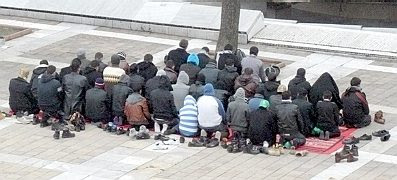



 My primary job is to be a propagandist: that is, my aim as an activist in the Counterjihad cause is to move the meme. Or, more fully, to move multiple memes.
My primary job is to be a propagandist: that is, my aim as an activist in the Counterjihad cause is to move the meme. Or, more fully, to move multiple memes.